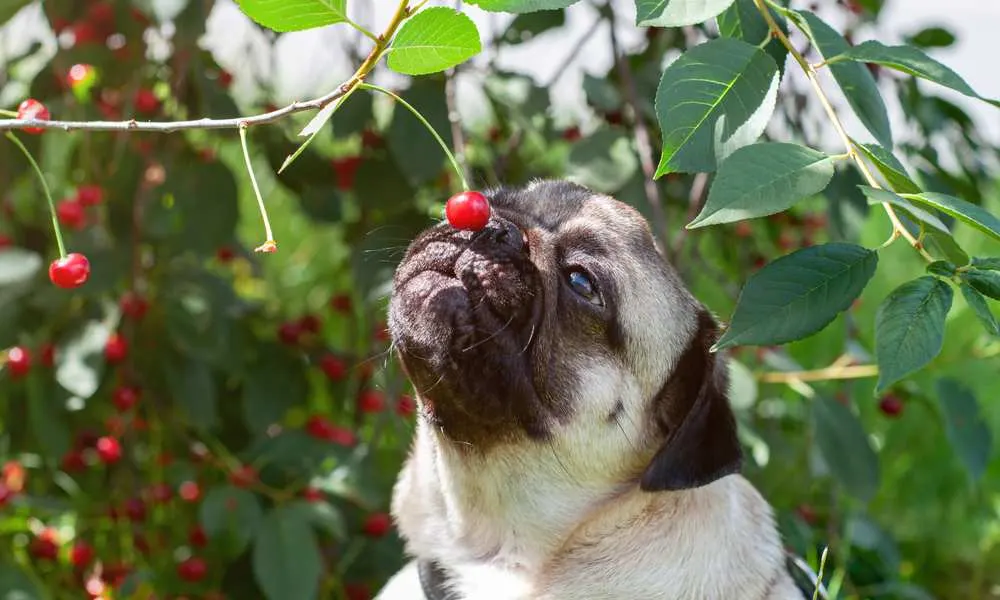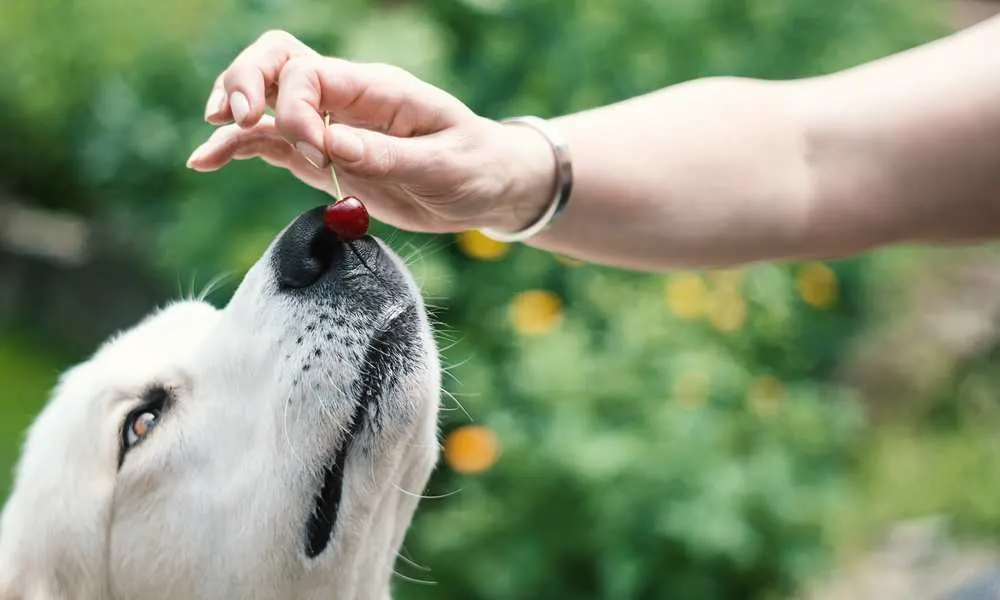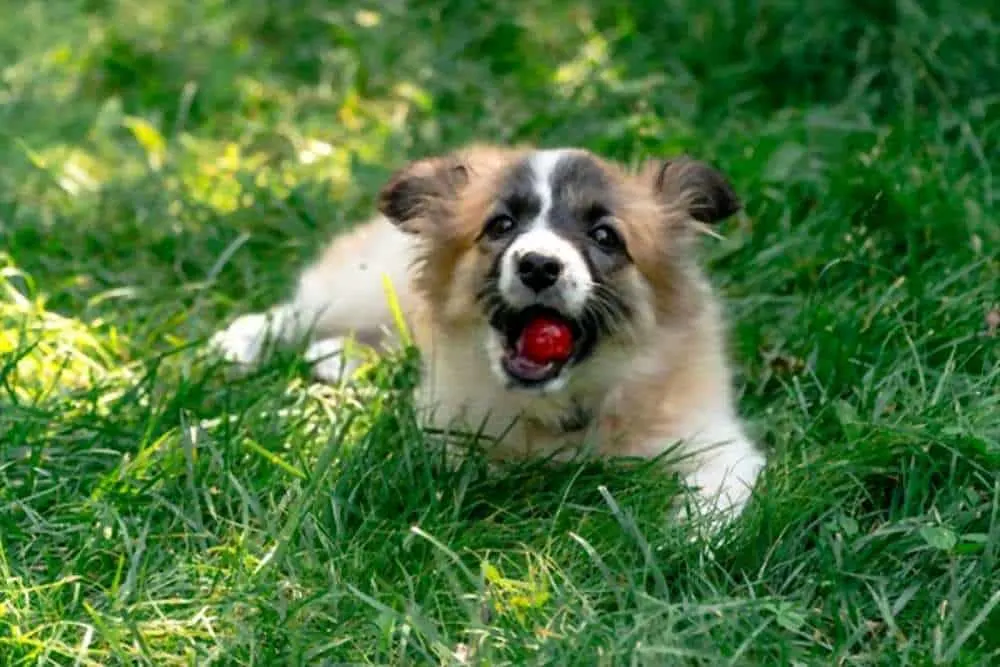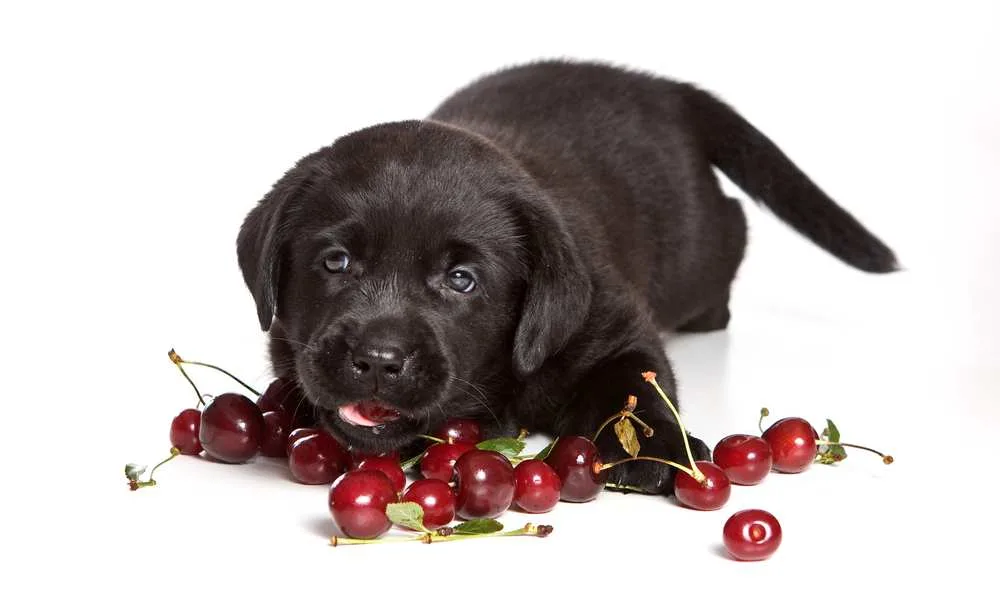There’s no better feeling than biting into a juicy piece of fruit, and one of my favorite fruits is the succulent cherry. Each one is like a tiny, bite-sized morsel of Mother Nature’s goodness! And like any dog owner, sometimes I’m tempted to toss some of that goodness to my dog, too.
Fresh fruits and vegetables can serve as a nutritious treat for our furry companions, so a couple of cherries won’t hurt my dog, right? Lucky for my best bud, I thought I should do a little research before sharing my bowl of cherries with him. Boy, am I glad did my research first.
Long story short: it’s okay for dogs to eat cherries…with caveats.

The Truth About Cherries
Cherries are part of a group of fruits known as “stone fruits.” These types of fruits have a hard pit, or “stone,” in their center. Peaches, apricots, and plums are some other examples of stone fruits.
Like other stone fruits, the only edible parts of the cherry are the flesh and skin. They contain high amounts of carbohydrates, fiber, and vitamin C. However, they’re not a significant source of these nutrients due to their small size.
Most people assume that a cherry pit is the same thing as a cherry seed. In actuality, the seed is inside of the pit itself. The hard shell of the surrounding pit protects the seed from harsh environments, such as the acidic digestive tract of an animal.
Cherry pits along with the pits of other stone fruits contain a chemical compound called amygdalin, which is released when the pit is crushed or chewed. Cherry stems and leaves also contain small amounts of amygdalin. Once ingested by an animal, amygdalin is metabolized into cyanide, which is toxic to dogs, humans, raccoons, secret agents, and pretty much anything else that breathes.

Dogs And Cherries
The flesh of cherry is safe for a dog to eat. The pit, stem, and leaves are not safe, thanks to their amygdalin content. Although the edible part of the cherry is relatively harmless, how many dogs do we know that can thoughtfully eat around a cherry pit without swallowing it?
Fresh Cherries
Undoubtedly, the part of a cherry that poses the most danger to our dogs is the pit. The pit must be crushed for the amygdalin to be released, which can happen easily if your dog is a strong chewer. Even if the pit is swallowed whole, it might cause an intestinal blockage in your dog. Therefore, cherries are only safe for your dog if the pits have been removed first.
Maraschino Cherries
Because they lack pits, you may think maraschino cherries are safe for dogs. Maraschino cherries are actually incredibly bad for dogs. Maraschino cherries are made by bleaching real cherries, then soaking them in a solution of preservatives, artificial coloring, and lots of sugar. In the end, the result is a sugar bomb that bears little resemblance to actual, natural cherries. Over time, too much sugar in the diet can lead to weight gain, obesity, and even diabetes. If you must give your dog a cherry, make sure it’s a fresh cherry with the pit removed.

What To Do If Your Dog Eats A Cherry Pit?
Accidents happen, especially with dogs. Most of us are familiar with all the creative ways our dogs can get to the food without us knowing, so it’s entirely possible for your pet to accidentally swallow a cherry pit.
Fortunately, a single cherry pit won’t produce harmful levels of cyanide, unless your dog is very small or very young. So if your dog happens to swallow a cherry pit, don’t panic right away. Instead, do the following:
1. Look For Signs Of Intestinal Blockage
The symptoms of intestinal blockage include vomiting, diarrhea, lethargy, and loss of appetite. If your dog is showing any of these symptoms after swallowing a cherry pit, you should contact your vet right away. Dogs with intestinal blockages often need surgery to correct the problem, so it can be a very serious condition. If your dog has swallowed a cherry pit and isn’t showing these symptoms, then you’ll probably see that cherry pit safely passed in your dog’s stool.
2. Look For Signs Of Cyanide Poisoning
In most cases, it would take several cherry pits to produce a harmful dose of cyanide, but amygdalin content can vary widely between individual cherries. Ideally, your dog has ingested zero cherry pits in his lifetime. If your dog does swallow a pit, keep an eye out for the following symptoms:
- Rapid breathing
- Drooling
- Bright red gums
- Convulsing
Cyanide poisoning from cherry pits isn’t very likely to happen, especially compared to the risk of intestinal blockage. However, dogs can die from cyanide poisoning minutes after showing symptoms. If your dog exhibits any symptoms of cyanide poisoning, then a visit to the emergency vet is in order.

Safer Alternatives To Cherries
Sure, cherries can be “good” for dogs, but they require a little prep before your dog can chow down. Some many other fruits and vegetables can be just as good for your dog’s diet, just without the risks of poisoning or blockage. Instead of feeding your dog a labor-intensive cherry, choose one of the following alternatives:
These snacks are just as nutritious as cherries, but they don’t require any extra supervision or prep work. They can just go straight from the produce bag to your dog’s mouth without having to remove pits or skins!
Plus, your dog is very unlikely to care whether he gets a juicy cherry or a juicy apple wedge.

Final Verdict
It’s okay for your dog to eat cherries, but please remove the pits and stems first. The risk of poisoning or blockage may be small, but the consequences can be dire.
If you’d rather not face the risk at all, treat your dog to an idiot-proof alternative, such as green beans or sweet potatoes. This way, your dog gets a safe and healthy snack, and you get to keep those cherries all to yourself.
Learn More: What Can Dogs Eat? A Comprehensive List Of Dog-safe Foods


